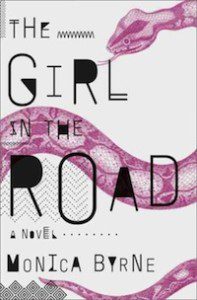
Let me disclose two things up front. This past year I was an editorial intern at the Frances Goldin Literary Agency, working for, among others, Monica Byrne’s agent. I also, like Byrne, went to Wellesley College, though she graduated seven years before me. While I have yet to meet Byrne through either of these channels, I heard a lot of buzz about her debut novel The Girl in the Road and could not wait to read it as soon as it came out. Just as one of the heroines of The Girl in the Road, Mariama, develops an infatuation with a goddess-like woman named Yemaya, I became obsessed with Byrne from afar before her book was even published. My feelings have only magnified since finishing her novel.
First things first: Byrne can tell a damn good story. Too often it seems contemporary literature becomes caught up in lyrical prose or heady contemplations, while nothing actually happens. In Byrne’s book, plenty happens. Her story captivated me within the first chapter. Luckily, at the time I happened to be waiting for a flight that was delayed four hours, so nothing prevented me from reading the novel straight through.
The Girl in the Road follows two parallel stories. In 2068, Meena, a young woman in her late twenties, decides to run away from her home country of India on the Trans-Arabian Linear Generator, also know as the Trail. A metal path running across the sea from Mumbai to Djibouti, the Trail conducts energy from the waves and is operated by a mega-company called HydraCorp. Mariama, a seven-year-old girl, is also running away, but her story takes place several decades before Meena’s, and she is coming from Western Africa to Ethiopia, riding illegally in a truck that transports oil. In these two stories, Byrne creates a world that feels entirely plausible. This is not the science fiction of faraway galaxies with spaceships and light sabers, but a realistic future 54 years from now, with politics, technology, and environmental issues that seem likely given the current state of the world. Byrne’s book is in the same vein as The Age of Miracles by Karen Thompson Walker or 1984 by George Orwell. In Byrne’s version of 2068, America has lost its superpower status to India, and the Ethiopian capital Addis Ababa is the next urban metropolis. Everyone has a computer chip embedded in their arm to track their location and send and receive information in the cloud, scanners are used to pay for goods, and each person is surrounded by a Facebook-like-profile and unique ID in a visible aura of information called an aadhaar. Glaciers have melted so much that many coastal cities have been wiped out, and people brace themselves for regular typhoons and cyclones. Byrne’s world feels so near that it seems less like she is making things up and simply sending dispatches from the future.
Byrne’s version of the future is fascinating, even if it occasionally overwhelms the plot. The government dynamics and environmental problems of Byrne’s world are enormous and stressful, and sometimes there are too many thoughts crammed into The Girl in the Road. Then again, that is how the world is – too much to take in all at once, already exhausting and overwhelming. I cannot comprehend how much more intense that constant flood of information will be in 54 years.
But it is the internal, emotional plot of the two characters—more so than the politics and technology—that drives the book. I believe in both characters, but I care about them too. Meena has been attacked and wounded in India, and she seeks the Trail in a soul-searching journey to come to terms with the murders of her parents at the time of her birth. Mariama is fleeing a sinister, frightening past and hoping for a better life in Addis Ababa. Though Byrne’s novel is categorized as science fiction, she spins an addictive mystery as the reader begins to understand how the two plot lines connect.

Beyond its genre categorizations, The Girl in the Road is a feminist manifesto. As Byrne writes, “the real show here is the divine feminine.” In some ways, Byrne’s 2068 has solved many problems for women. There has been another sexual revolution, this time in India, and now people are out as trans*, polyamorous, bisexual, and homosexual without a second thought. Meena has had relationships with men and women – her most current partner was a transwoman named Mohini – and her sexuality is commonplace in the world of the novel. Additionally, by 2068, all STDs are treatable by nanobiotics, and both men and women are automatically given birth control upon reaching puberty, which can be easily deactivated if and when the individual wants to start a family. For many women today, this sounds like a dream world.
What is troubling in The Girl in the Road are not the things that are different in 2068, but the things that have remained the same. Class differences between the poor and the wealthy are still extreme. Terrorist attacks continue to be common, even if the warring groups have changed. Humans are still trafficked into slavery. And, even 54 years from now, women are the regular victims of physical violence and rape.
Before setting out on the Trail, Meena worked at a women’s clinic. Women are still taught to be ashamed, not proud, of their bodies. Women are still beaten and raped and left to die on the side of the road. Women are still sold into sexual slavery. Women are still seen as lesser than men and, as Meena angrily thinks on the Trail, “I fucking hate it when anyone assumes I’m harmless because I am a woman.” Women still excuse the violence they experience as normal: “He just needed to get his frustration out of his system.” I was moved by Byrne’s book because of her willingness to honestly address the horrors that women face – women of all ages, races, and classes, across the globe. Byrne does not shy away from brutal truths. “We’re all children of rape, somewhere in our lineage,” Meena’s girlfriend Mohini tells her at one point. There is one particularly painful scene of child abuse in a hotel room. Byrne talks about that scene on her blog (spoilers there) and about the backlash to it: “I was told several times, by prospective agents and editors, that I needed to ‘dial it back’ or ‘tone it down.’ One of the reasons I chose my agent was that he was the only one to confirm my instinct: that I was telling the truth, and needed to leave it be.” Byrne has been accused of condoning child rape for writing this scene, but like those who think of Vladimir Nabokov as a pervert for creating Lolita, some readers, as Byrne writes, “confuse reportage with advocacy.” Byrne is actually showing how childhood trauma can affect an individual for the rest of her life.
Byrne wrote recently for The Atlantic about the dangers of “writing what you know.” Since privileged, white men have dominated the English literature scene for so many centuries, it is privileged, white, male characters who have been the heroes for as many years. “Despite a liberal upbringing and an education at a women’s college,” Byrne writes, “it didn’t occur to me that my identification with male heroes had damaged me in any way—that is, until I became a writer, and found myself weirdly reluctant to write a woman hero. This wasn’t an accident.” In The Girl in the Road, Byrne has written two woman heroes with brown skin. With my own liberal upbringing and education at the same women’s college, I am wary when a person of privilege decides to speak for someone without, but Byrne is self-aware and has grappled with her decision. She understands that it is not perfect, but she hopes it is a start: “As an American able-bodied, middle-class, mostly straight cis white person, I lack privilege in just one dimension: being a woman,” Byrne writes. “But I can summon experiences of that non-privilege—the daily reminders that I’m a special subset of human, rather than human, full stop—to make me understand who, by omission, literature instructs me to dehumanize.”
And so Byrne has created Meena and Mariama—both female, Indian and African respectively—who are not the stereotypical Strong Female Characters. Both are strong, yes – they could not survive their respective journeys without strength – but both are weak, vulnerable, and jealous too, and much affected and abused by the world around them. In short, they are people: two female characters who are as multifaceted and three-dimensional as the male characters that have populated the English canon for centuries. The Girl in the Road battles a giant and succeeds in inflicting a small wound. I hope Byrne will continue in this direction and other writers will follow her lead. If they do, we will begin to see more Indian and African writers dominating English literature. Until then, writers with privileged need to examine their own biases and motives. “Humanization—the recognition of the ‘other’ as equally valuable as oneself—is foundational to giving and receiving love and compassion,” Byrne has said, and not just literature, but the whole world, needs more of that.




